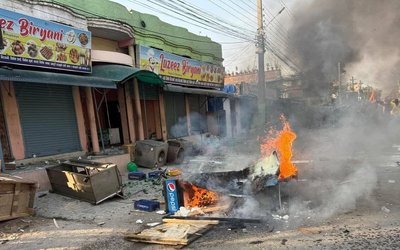More on News






WASHINGTON, May 16, 2016- A new report is warning that the world is ill-prepared for an increasing rise in disasters, spurred by climate change, rising populations and increasing vulnerability of people in large cities and unregulated housing.
The report, The Making of a Riskier Future: How Our Decisions are Shaping the Future of Disaster Risk, calls for a radical new approach to assessing risk, which takes into account extremely rapid changes in global disaster risk. Annual total damages from disasters have been increasing for decades and models show that population growth and rapid urbanization could put 1.3 billion people and $158 trillion in assets at risk from river and coastal floods by 2050.
“With climate change and rising numbers of people in urban areas rapidly driving up future risks, there’s a real danger the world is woefully unprepared for what lies ahead,” said John Roome, the World Bank Group’s Senior Director for Climate Change. “Unless we change our approach to future planning for cities and coastal areas that takes into account potential disasters, we run the real risk of locking in decisions that will lead to drastic increases in future losses. “
In examining literature and case studies from around the globe, the report cites studies showing that densely populated coastal cities are sinking and when coupled with rising sea levels, annual losses in 136 coastal cities could increase from US$6 billion in 2010 to US$1,000 billion in 2070.
It also cites research warning that in Indonesia, river flood risk may increase 166 percent over the next 30 years due to rapid expansion of urban areas, while the country’s coastal flood risk could rise by 445 percent. Earthquake risk in Kathmandu is expected to double to 50 percent by 2045 due to informal building expansion.
At the heart of effective disaster risk management is reliable and accessible risk information. To help catalyze a move towards dynamic, accessible, and actionable risk information, the Global Facility for Disaster Reduction and Recovery (GFDRR) and the World Bank are also releasing ThinkHazard!– the first of its kind open-source platform to provide hazard information and recommendations of how to reduce risk across eight hazards including earthquakes, floods, tsunamis and cyclones for 196 countries.
“By promoting policies that reduce risk and avoiding actions to drive up risk, we can positively influence the risk environment of the future,” said Francis Ghesquiere, Head, GFDRR Secretariat “The drivers of future risk are within the control of decision makers today. They must seize the moment.”
This month over 700 experts and thought leaders will gather in Venice to examine the critical role of technological advances in disaster risk management. The 2016 Understanding Risk Forum, hosted by GFDRR, will showcase the latest innovations, exchange ideas and form partnerships on risk identification and assessment.
Taking place in Venice, Italy, a city highly vulnerable to climate change, the Forum will host high level panels and live demonstrations from companies showcasing cutting-edge technologies.






